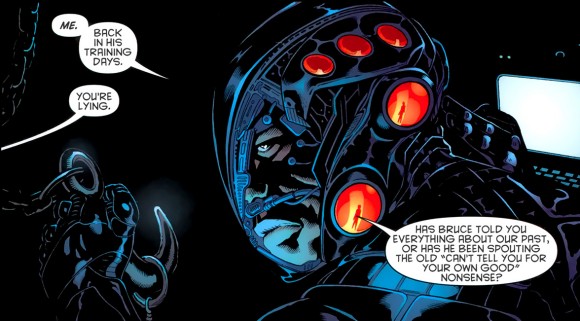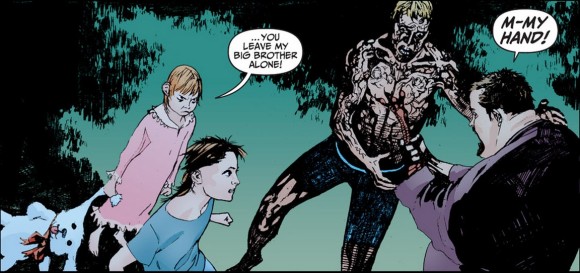The Battle for the Cowl so far is comprised of three main books, numerous associated mini-series, and a few scattered one-shot tie-ins. I’m not strongly affected either way by most of these, but this week two of those one-shots loom large in my mind.
The first is an example of the perfect tie-in. It shows us something we never would have seen if we were following a conventional narrative, and offers us something truly different from the norm while still maintaining the tone of the world for which it was created. That one was Battle for the Cowl: Arkham Asylum. Written by David Hine, it takes us on a tour of Arkham Asylum, and for once focuses on the less gruesome aspects of the institution. Jeremiah Arkham narrates the story, not in the usual hard-boiled tone taken by the Gotham crowd, but with sincere sadness that he hasn’t been able to help the inmates.
While we sense that he is somewhat unhinged himself, he’s an eccentric and an idealist, not the usual film-noir lunatic. He finds picks a few inmates who pose no threat, and leads them out of the ruined structure. In the end, before the final, worrying sting, he expresses the hope that he can rebuild the asylum so that it lives up to its name – so that it can be a true asylum for those who are unable to survive in the conventional world. It’s refreshing, it’s sobering, and it’s creative.
Sadly, I only really got to thinking about how excellent it was while reading Battle for the Cowl: The Network. Well, now I know something about myself, at least. Pissiness is a bigger motivator than honest admiration.
So let’s get to it!
Well, first thing’s first. Huntress’s costume has been changed back to a glorified bikini. And why? Because the promotional poster for the event, drawn by Tony Daniel, has her back in her Jim Lee costume. I don’t see why this would necessitate a costume change in the actual book any more than the ‘The Real Power In The DCU’ poster would necessitate putting every woman in the DCU in a white evening dress, but I guess that’s how they’re going to play it.
Honestly? I didn’t even notice the costume change. A girl fighting crime in a bikini doesn’t catch my eye anymore. What made me notice was the characters in the story can’t stop picking at the new outfit. Batgirl, still with a perfect command of the English language, mentions it once. Oracle mentions it later. Both talk about how impractical it is.
I don’t know why. Maybe it’s a jab by writer at a mandated costume change. Maybe he’s was trying to have his cake and eat it, too, by putting Huntress in a two-piece bathing suit and still snarking about it. I’m not sure who made the decisions to regress Huntress sartorially.
I just know that the decision was also made to regress her personally. When the villain announces that he will start murdering two hostages if the heroes don’t murder one, Huntress pulls her crossbow and is about to take a hostage out when Batgirl knocks her aside. This is the deal-breaker for me. Cass is back on the moral high ground, but she had to knock Helena off it to get there. Never mind that in continuity we haven’t seen Huntress kill in years. Never mind that we’ve never seen her kill that casually. In the end, the plot of this book involves the worst mistake a team book can make: cutting off one character at the knees to make another character look good. That’s never the way to go.
In short: Buy Battle for the Cowl:Arkham Asylum. Leave Battle for the Cowl: The Network on the shelf. And stop making women fight in swimwear.





